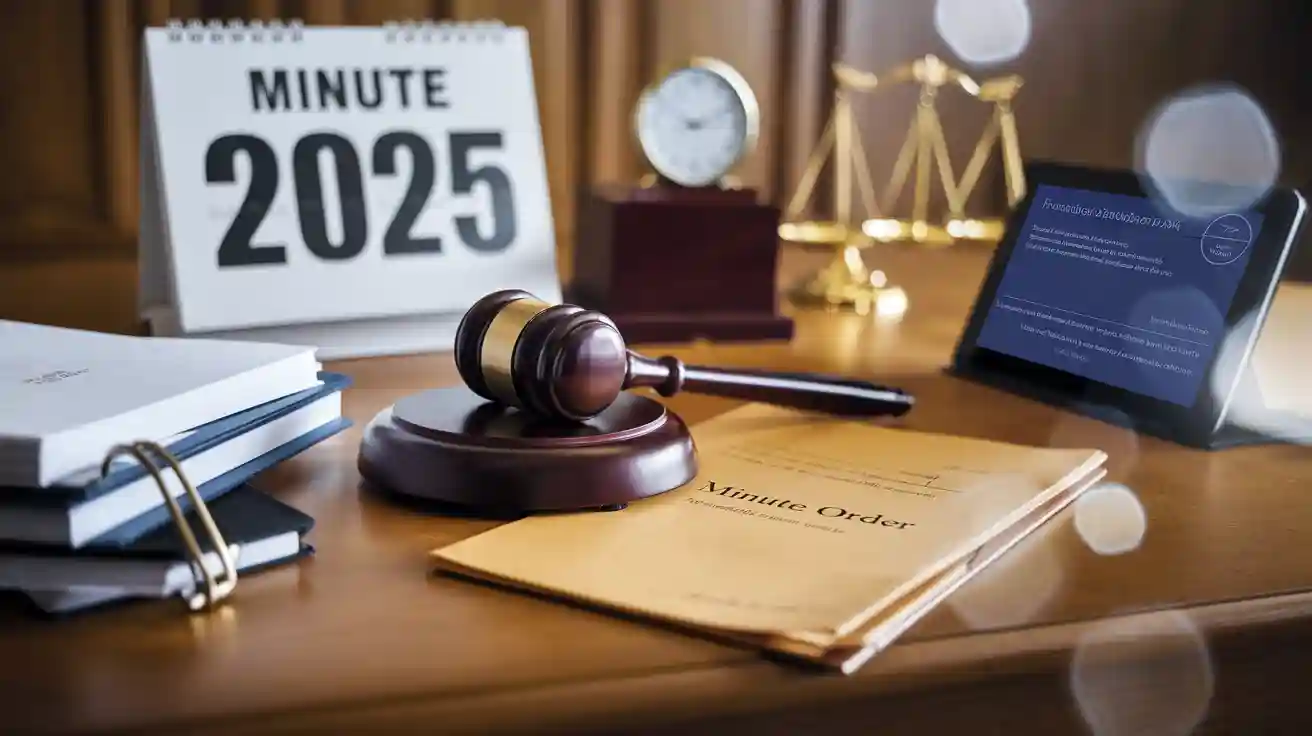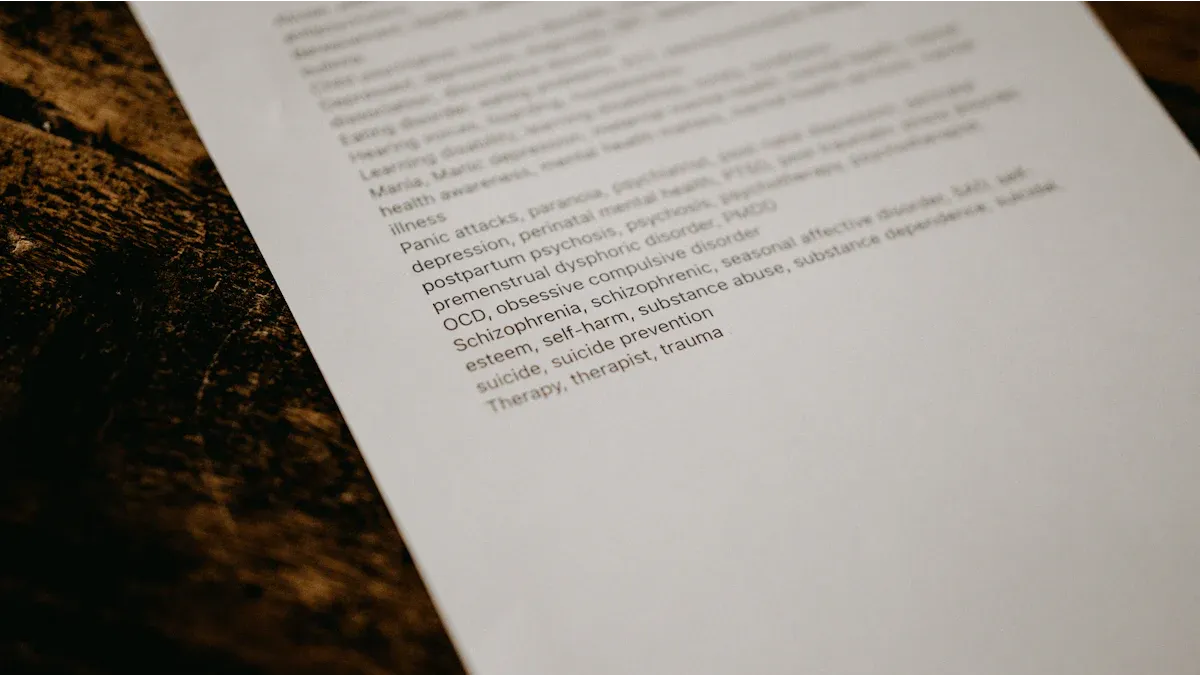Minute Orders in Court What You Need to Know in 2025

A minute order records what happens during a court hearing. The court clerk writes these official notes to show what the judge decides. Many people do not realize that minute orders can have legal power. Each minute order helps everyone follow the case and see the court’s actions. Minute orders keep the process open and fair. People who read their minute orders protect their rights and know what steps to take next in court.
Minute Orders Explained

What Is a Minute Order
A minute order is an official record of what happens in court during a hearing or trial. The court clerk prepares this document, which summarizes the judge’s decisions or instructions. Most minute orders do not need the judge’s signature. They serve as a brief summary of the court’s actions and can be either oral or written. The court enters each minute order into its official minutes, making it a recognized court order. In many cases, typical minute orders act as temporary records until the court issues a more detailed written order.
Note: Typical minute orders are common in family law cases, where judges make quick decisions that need to be recorded right away.
Legal Significance
Minute orders carry legal weight. The court treats them as binding instructions or decisions. When a judge issues a minute order, everyone involved in the case must follow it. These orders can address many issues, such as scheduling, support payments, or restraining orders. Minute orders often serve as the basis for enforcement actions. For example, if someone fails to comply with a minute order, the court may start contempt proceedings or order wage garnishment.
Minute orders also play a key role in appeals. Lawyers and parties can use them as evidence to show what the judge decided during a hearing. Sometimes, a certified copy of the minute order is needed for an appeal. In other cases, the court may require a more formal written order for clarity. Still, courts and case law recognize minute orders as important documents that can affect the outcome of a case.
Minute Orders vs. Dockets
Minute orders and court dockets both track what happens in a case, but they serve different purposes. A minute order records the judge’s specific decisions or instructions during a hearing. The court clerk writes these orders to capture the outcome of each court appearance. In contrast, a court docket is a running list of all events and filings in a case. The docket shows dates, document titles, and actions taken, but it does not include the details of the judge’s decisions.
| Feature | Minute Order | Court Docket |
|---|---|---|
| Purpose | Records judge’s decisions | Lists all case events and filings |
| Prepared by | Court clerk | Court clerk |
| Legal Effect | Can be binding and enforceable | Informational only |
| Level of Detail | Summarizes court orders or rulings | Basic event and filing info |
Understanding the difference helps parties know where to look for important information. Minute orders provide the details of what the judge decided, while the docket gives an overview of the case’s progress.
Impact of Minute Orders
Case Progress
Minute orders play a key role in tracking the progress of court hearings. Each time the judge makes a decision, the court clerk records it in a minute order. This process helps everyone involved in the case understand what happened during the proceedings. Attorneys, parties, and even outside agencies can review these records to see the latest updates.
Minute orders act as a timeline for the case. They show when the judge made decisions and what those decisions were. This record helps prevent confusion about the status of the case or the next steps required.
When a case involves multiple hearings, minute orders help keep the proceedings organized. They allow parties to prepare for future hearings by reviewing past decisions. This system supports transparency and ensures that no one misses important information from the court.
Binding Effect
Minute orders often have a binding effect on the parties involved, especially in family law cases. The court uses these orders to communicate interim decisions that must be followed until a more formal court order is issued. The following points highlight how a minute order can be legally binding and its limitations:
- The court clerk prepares the minute order after each hearing, summarizing the judge’s decision.
- Minute orders do not require the judge’s signature to be effective as interim instructions.
- They often address urgent matters, such as child custody, support, or restraining orders.
- These orders serve as temporary records until the court files a formal, signed order.
- Because they are interim and unsigned, their enforceability is limited compared to final court orders.
A judge’s ruling, including a minute order, does not become fully enforceable until the judge signs it and the court files it. Oral rulings or unsigned orders generally lack the power for enforcement or appeal. Until the court enters a signed order into the record, the judge may still change the decision. For this reason, parties should treat minute orders as important but recognize their limitations during ongoing proceedings.
Obtaining a Copy of a Minute Order

Online Access
Many courts now offer online portals for obtaining a copy of the minute order. The process is straightforward and secure. Most users follow these steps:
- Create an account on a trusted legal platform, such as Rapid Legal.
- Choose the service for document retrieval and select the correct court or jurisdiction.
- Submit a request for the copy of the minute order.
- Track the request with real-time updates from the platform.
- Receive a court-stamped copy of the minute order electronically.
- Some services allow users to request a courtesy copy delivered to the courthouse.
Online systems use strong security measures. Users must follow terms of use and protect their login information. Courts require two-factor authentication, complex passwords, and encrypted connections. These steps help keep sensitive court records safe.
Tip: Many platforms offer both do-it-yourself and concierge options. Users can order documents themselves or have an expert handle the process.
In-Person Requests
Some people prefer to visit the courthouse in person. The process for obtaining a copy of the minute order is simple:
- Go to the courthouse where the case file is stored.
- Provide the court staff with the case number.
- Show a picture identification card to verify identity.
No other documents are usually required. The court staff will help locate the file and provide a copy of the minute order upon request.
Timing
Anyone involved in the case, such as parties or attorneys, can request a copy of the minute order. Processing times vary. Online requests often take a few hours to a few days, depending on the court’s workload. In-person requests may be completed the same day if the file is available. Some courts may need extra time for older or archived files.
Note: Always check with the specific court for current procedures and expected wait times.
Correcting Errors in Minute Orders
Identifying Mistakes
Mistakes in minute orders can happen. Parties often spot errors by carefully reviewing draft minutes before the next court session. Courts or clerks may send these drafts to involved parties or attorneys for review. People look for factual errors, missing information, or incorrect statements about what the judge decided.
A structured process helps everyone catch mistakes early:
- The court clerk records the judge’s decisions during the hearing.
- Draft minute orders are shared with parties or their attorneys before the next hearing.
- Each person reviews the draft for accuracy, checking dates, names, and the judge’s instructions.
- Parties note any factual errors or missing details and prepare to suggest corrections.
- Courts may use secure online portals or board management tools to share and store these drafts.
- Some courts use AI-powered tools to help capture and format minutes, making review easier.
- Guidelines, such as Robert’s Rules of Order, provide a clear process for reviewing and approving corrections.
Tip: Reviewing minute orders as soon as possible helps prevent confusion and protects everyone’s rights.
Steps to Fix Errors
When someone finds a mistake in a minute order, they should act quickly. Courts expect parties to raise concerns before the next hearing or as soon as they notice the error. The process usually follows these steps:
- Notify the court clerk or judge in writing about the specific error.
- Clearly describe what is wrong and suggest the correct information.
- Bring up the correction at the next court hearing if possible.
- The judge or court will review the request and decide if a correction is needed.
- If approved, the court will update the official record and share the corrected minute order.
Prompt action ensures the official record stays accurate. Corrections focus only on factual mistakes, not on changing the judge’s decisions. Courts want to resolve errors quickly so that everyone can rely on the official record for future steps.
Next Steps After a Minute Order
Understanding Your Options
After receiving a minute order, individuals involved in family law proceedings should review the document carefully. The next steps depend on the type of decision made by the court. Many people need to address issues such as child custody, child support, or child custody arrangements. Several resources can help parties understand and respond to the court’s instructions:
- Mediation programs can help resolve disputes about child custody or child support.
- Public defender services are available for criminal cases.
- Attorney help desks offer free consultations for certain case types, including family law.
- Self-help centers provide procedural information and access to court-approved forms for child support payment orders and other matters.
- Early resolution programs assist with uncontested divorces.
- Attorney consultations are available for family law, landlord/tenant, and small claims cases, with appointments charged by the minute.
Self-help centers clarify that their assistance is procedural. They do not create attorney-client relationships. For detailed legal advice, parties should consider consulting a private attorney. These options help individuals understand their responsibilities and prepare for future proceedings.
Tip: Reviewing the minute order promptly ensures that deadlines for appeals or motions are not missed.
A signed minute order can serve as a final order. This document triggers the timeline for filing an appeal. The appeal must be filed in the correct court within 14 days of the final order. Without a signed minute order, the appeal process cannot begin.
When to Seek Legal Help
Legal assistance becomes important in several situations after a minute order. Individuals should seek help if the order is unclear or incomplete, especially if it lacks details such as the start date for child support. Filing a motion with the court may be necessary to request clarification or modification.
- Consult a family law attorney to prepare and file legal documents related to child support or child custody.
- Use legal counsel to navigate court procedures and protect rights during family law proceedings.
- Take action if the opposing party causes delays or fails to follow the order, especially for child support payment orders.
- Request a hearing to correct or clarify the minute order if needed.
Legal professionals can help enforce child support, address errors, and ensure compliance with the court’s decisions. Timely action helps prevent complications and supports the best outcome for all parties.
Understanding minute orders helps individuals follow court decisions and protect their rights. Legal experts note that prompt review of these orders prevents missed deadlines and errors.
Timely action, such as requesting corrections or seeking legal help, can make a difference in case outcomes.
- Minute orders often shape court results, especially in urgent cases like election disputes.
- Courts use minute orders to address last-minute changes and ensure fair processes.
Reliable resources, including legal websites and law firms, offer guidance on minute orders and their legal effects. Staying informed supports better results in court.
FAQ
What should someone do if they lose their minute order?
If a person loses a minute order, they can request a new copy from the court clerk. Many courts offer online access. The requester must provide the case number and show identification. Quick action helps avoid missing important deadlines.
Can anyone view or request a minute order?
Most minute orders are public records. Any person can request a copy unless the case is sealed or confidential. Family law and juvenile cases may have restrictions. The court clerk can explain access rules for each case type.
How long does it take to receive a minute order?
Processing times vary by court. Online requests may take a few hours to a few days. In-person requests often finish the same day. Older or archived files may require extra time. Checking with the court helps set expectations.
Are minute orders always final decisions?
Minute orders often record temporary or interim decisions. Some become final if the judge signs them. Others serve as a record until a formal written order is issued. Parties should review each order to understand its effect.
What happens if a minute order contains confidential information?
The court may redact sensitive details before releasing the minute order. Parties should alert the clerk if they see private information. Courts follow strict rules to protect privacy in family law and juvenile cases.
See Also
Ensuring Long-Term Success In B2B Order Fulfillment
How Delayed Remote Fulfillment Affects E-Commerce Orders
Important Amazon FBM Fee Changes Coming In 2025